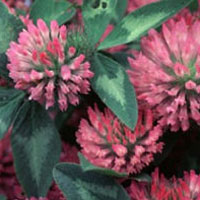Red Clover
 © Steven Foster
© Steven FosterParts Used & Where Grown
This plant grows in Europe and North America. The flowering tops are used in botanical medicine. Another plant, white clover, grows in similar areas. Both have white arrow-shaped patterns on their leaves.
- Reliable and relatively consistent scientific data showing a substantial health benefit.
- Contradictory, insufficient, or preliminary studies suggesting a health benefit or minimal health benefit.
- For an herb, supported by traditional use but minimal or no scientific evidence. For a supplement, little scientific support.
Our proprietary “Star-Rating” system was developed to help you easily understand the amount of scientific support behind each supplement in relation to a specific health condition. While there is no way to predict whether a vitamin, mineral, or herb will successfully treat or prevent associated health conditions, our unique ratings tell you how well these supplements are understood by the medical community, and whether studies have found them to be effective for other people.
For over a decade, our team has combed through thousands of research articles published in reputable journals. To help you make educated decisions, and to better understand controversial or confusing supplements, our medical experts have digested the science into these three easy-to-follow ratings. We hope this provides you with a helpful resource to make informed decisions towards your health and well-being.
This supplement has been used in connection with the following health conditions:
| Used for | Amount | Why |
|---|---|---|
Menopause | 80 mg of isoflavones daily | Red clover is an herb with weak estrogen-like actions similar to soy. In one study, isoflavones from red clover reduced the frequency of hot flashes in postmenopausal women. |
Osteoporosis | Take an extract supplying 26 mg of biochanin A, 16 mg of formononetin, 1 mg of genistein, and 0.5 mg of daidzein per day | In one study, supplementing with isoflavones from red clover reduced the amount of bone loss from the spine by 45%, compared with a placebo. |
Cough | Refer to label instructions | Red clover has a long history of use for relieving coughs. |
Eczema | Refer to label instructions | Red clover has been used historically to treat people with eczema. |
Traditional Use (May Not Be Supported by Scientific Studies)
Traditional Chinese Medicine and Western folk medicine used this plant as a diuretic, a cough expectorant (an agent that promotes discharge of mucus from the respiratory passages), and an alterative.1 Alterative plants were considered beneficial for chronic conditions, particularly those afflicting the skin.
Copyright © 2026 TraceGains, Inc. All rights reserved.
Learn more about TraceGains, the company.
The information presented by TraceGains is for informational purposes only. It is based on scientific studies (human, animal, or in vitro), clinical experience, or traditional usage as cited in each article. The results reported may not necessarily occur in all individuals. Self-treatment is not recommended for life-threatening conditions that require medical treatment under a doctor's care. For many of the conditions discussed, treatment with prescription or over the counter medication is also available. Consult your doctor, practitioner, and/or pharmacist for any health problem and before using any supplements or before making any changes in prescribed medications. Information expires December 2026.










